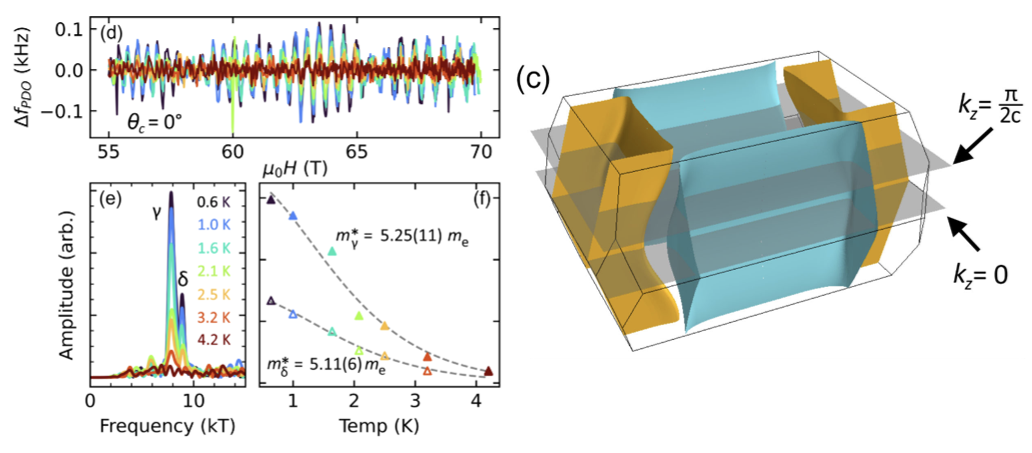Alex Eaton, University of Cambridge, UK and Yurii Skourski, HLD.
Scientists from the UK, USA, Czech Republic, and Germany have studied the Fermi surface of the heavy-fermion superconductor UTe2. This material is of particular interest given its high likelihood of hosting a spin-triplet Cooper-pairing mechanism. Evidence for this stems primarily from the observation of only a small change in the NMR Knight shift on cooling through Tc, along with anisotropic upper critical fields that greatly exceed the Pauli limit in all directions. The dimensionality of Fermi-surface sheets in triplet superconductors can have important implications regarding the possible topological properties of the superconductivity. A recent study of the magnetoconductance of UTe2 was interpreted as indicating the presence of a 3D Fermi-surface pocket. Here, by combining high-field magnetoconductance oscillation measurements using a 70 T coil at HLD-Dresden along with measurements in the 41 T resistive magnet in Tallahassee, researchers were able to show that actually the profile of the magnetoconductance oscillations in UTe2 can be very well described by considering quantum interference between magnetic-breakdown orbits across quasi-2D Fermi-surface sections previously identified in dHvA-effect studies. Such quantum interference effects – first observed by Stark in the 1970s in experiments on magnesium – occur when the k-space separation between Fermi-surface sheets is very small, allowing quasiparticles to tunnel across the sheets in accessible magnetic-field strengths. Furthermore, the datasets of this study were found to be incompatible with the presence of any 3D Fermi-surface pockets. This confirmation of the quasi-2D nature of the UTe2 Fermi surface sets the groundwork for future theoretical developments. Excitingly, the Fermi surface of UTe2 appears to be remarkably simple, consisting exclusively of two cylindrical sheets of hole and electron type, respectively. This is markedly simpler than comparable heavy-fermion systems such as UPt3 , URhGe, etc., which possess complex multisheet Fermiologies. Despite a wealth of exotic physical phenomena at play in UTe2, the simplicity of its electronic structure gives hope that meaningful theoretical progress at understanding this material is within our grasp.

Figure: Quantum-interference oscillations measured in a 70 T pulsed magnet at HLD by the PDO technique, alongside a rendering of the quasi-2D Fermi-surface sheets of UTe2.
Quantum Interference between Quasi-2D Fermi Surface Sheets in UTe2, T. I. Weinberger, Z. Wu, D. E. Graf, Y. Skourski, A. Cabala, J. Pospíšil, J. Prokleška, T. Haidamak, G. Bastien, V. Sechovský, G. G. Lonzarich, M. Vališka, F. M. Grosche, and A. G. Eaton, Phys. Rev. Lett. 132, 266503 (2024).
https://journals.aps.org/prl/abstract/10.1103/PhysRevLett.132.266503
Contact: alex.eaton@phy.cam.ac.uk






